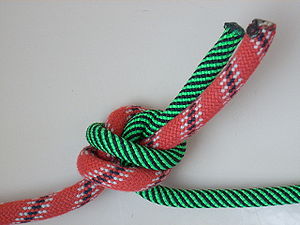- One-sided overhand bend
-
Overhand Bend Names Overhand Bend, European Death Knot (EDK), One-sided overhand bend, Flat overhand bend, Offset overhand bend, Thumb knot, Thumb bend, Creeler's knot, Openhand knot Category Bend Origin Ancient Related Overhand knot, Water knot Releasing jamming Typical use sewing, weaving, baling, climbing, rappelling ABoK #246, #359, #1236, #1410, #1557, #1558, #3789 The overhand bend is a knot used to join two ropes together. The overhand bend is formed by holding two rope ends next to each other and tying an overhand knot in them as if they were a single line. Due to its common use in several fields, this bend has become known by many names.
Contents
Uses
Easily formed in most line, the overhand bend can be difficult or impossible to untie once tightened.[1] Long used by weavers to join the ends of yarn, the overhand bend is very old. It was one of the knots likely identified among the possessions of Ötzi the Iceman, who dates from 3300 BC.[2] The knot is also tied in a slipped form by mechanical balers to bind straw and hay, but this bend is not practical to use as a binding knot when tied by hand.[3]
In climbing and mountaineering
In climbing, the overhand bend is one of several knots used for joining two ropes for a rappel longer than half the length of the ropes. It is prone to failure by capsizing under high loads. Due to this behavior, American climbers often refer to it as the European Death Knot or EDK. But these initial failures can reform the knot tighter, if the ends are long enough to avoid passing into the knot.[4]
Despite questions about this knot's security, it does present some advantages for use in rappels. Because the bulk of the knot is not in line with the rope, it can slide more easily over mountain terrain than other bends. Along with its comparatively small size, this aids in rope retrieval by reducing its chance of getting stuck on edges, in cracks, or descent equipment. Since a stuck rope on a descent also represents a serious hazard to climbers, these advantages, along with ease of tying, have led to its popularity. It is recommended by some sources with the caveats that the ends be left very long (>30 cm), the knot be carefully dressed and fully tightened by pulling individually on all four strands, and then subjected only to moderate rappelling loads.[5]
The one-sided or Offset Figure Eight Bend, a similar knot using the figure-eight knot, has been used in the belief that its greater size and complexity brings more security. But testing and more than one fatal failure indicate the figure-eight variant to be less secure, more prone to capsize at lower loads, and in capsizing uses more of the ends than does a capsizing overhand bend.[4][5] Moreover, while there is one obvious proper dressing of the Overhand Bend, there are a couple of dressings for the Offset Figure Eight Bend.[citation needed]
See also
- List of bend knots
- List of knots
References
- ^ Cyrus Lawrence Day (1986), The Art of Knotting and Splicing (4th ed.), Annapolis: Naval Institute Press, pp. 52–53
- ^ van der Kleij, Gerre (1996), "On Knots and Swamps", in Turner, J.C.; van de Griend, P., History and Science of Knots, K&E Series on Knots and Everything, 11, Singapore: World Scientific Publishing, pp. 34–35, ISBN 9810224699
- ^ Ashley, Clifford W. (1944), The Ashley Book of Knots, New York: Doubleday, p. 45
- ^ a b [|Tom Moyer] (1999-11-09), Rope and Gear Testing: Pull Tests of the "Euro Death-Knot", http://www.xmission.com/~tmoyer/testing/EDK.html
- ^ a b Soles, Clyde (2004), The Outdoor Knot Book, Seattle: The Mountaineers Books, pp. 125–127, ISBN 978-0-89886-962-0
Categories:- Bend knots
- Climbing knots
Wikimedia Foundation. 2010.

